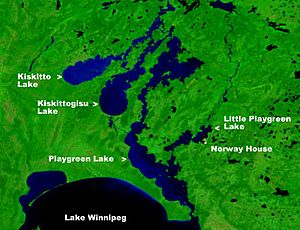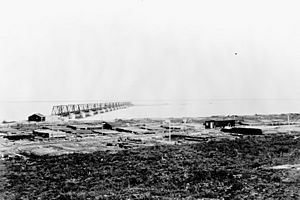Nelson River facts for kids
Quick facts for kids Nelson River |
|
|---|---|
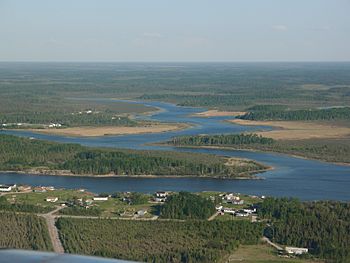
Nelson River near Norway House
|
|
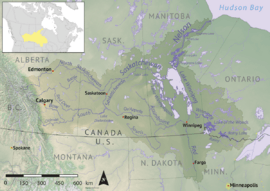
Map of the Nelson River drainage basin
|
|
| Native name | Powinigow Sipi |
| Country | Canada |
| Province | Manitoba |
| Physical characteristics | |
| Main source | Lake Winnipeg 217 m (712 ft) 53°41′20″N 97°50′52″W / 53.68889°N 97.84778°W |
| River mouth | Hudson Bay 0 m (0 ft) 57°5′5″N 92°30′8″W / 57.08472°N 92.50222°W |
| Length | 644 km (400 mi) |
| Basin features | |
| Basin size | 1,072,300 km2 (414,000 sq mi) |
| Tributaries |
|
The Nelson River is a big river in Manitoba, Canada, located in north-central North America. It flows out of Lake Winnipeg and travels about 644 kilometers (400 miles) before reaching Hudson Bay.
If you include its longest branches, like the Saskatchewan River and Bow River, the whole river system is about 2,575 kilometers (1,600 miles) long. The river carries a lot of water, about 2,370 cubic meters (83,700 cubic feet) every second. Its drainage basin (the area of land that collects water for the river) covers about 1,072,300 square kilometers (414,000 square miles). A part of this area, about 180,000 square kilometers (69,000 square miles), is in the United States.
Contents
River's Journey: Where the Nelson River Flows
The Nelson River starts its journey from Lake Winnipeg. First, it flows into Playgreen Lake. From there, it splits into two main channels that lead to Cross Lake.
The east channel, along with the Jack River, flows from the southeast part of Playgreen Lake into Little Playgreen Lake. Then, the Nelson east channel continues north, passing through Pipestone Lake on its way to Cross Lake. The west channel flows from the northern parts of Playgreen Lake, Kiskittogisu Lake, and Kiskitto Lake. It also reaches Cross Lake near the Manitoba Hydro's Jenpeg Generating Station and Dam.
After Cross Lake, the river continues its path through Sipiwesk Lake, Split Lake, and Stephens Lake. Finally, it empties into Hudson Bay.
Connected River Systems
Because the Nelson River drains Lake Winnipeg, it is the final part of several large river systems. These include the huge Saskatchewan River system, as well as the Red River and Winnipeg River.
One interesting fact is about Devils Lake in North Dakota. This lake is usually "closed," meaning water doesn't flow out of it. However, it has overflowed into the Red River at least five times since the last ice age.
Besides Lake Winnipeg, the Nelson River also gets water from other important rivers. These include the Grass River, which flows through a long area north of Lake Winnipeg. Another key river is the Burntwood River, which passes through the town of Thompson, Manitoba.
Communities Along the River
The Nelson River flows into Hudson Bay at a place called Port Nelson. This used to be a busy port but is now a ghost town. It's located just north of the Hayes River and York Factory.
Other communities you can find along the river, as you travel upstream from Hudson Bay, include Bird, Sundance, Long Spruce, Gillam, Split Lake, Arnot, Cross Lake, and Norway House.
Transportation and Ports
North America has only one port on the Arctic Ocean that is connected to the main railway system. This port is at Churchill, Manitoba, located at the mouth of the Churchill River.
Originally, there were plans to build port facilities at Port Nelson, at the mouth of the Nelson River. Early ideas for the railway link to Hudson Bay suggested Port Nelson as the end point. However, building a port there faced many challenges, which led to the decision to move the port to Churchill instead.
One big problem was that the Nelson River's water carried a lot of silt (fine dirt or sand). This meant the port would need constant and extensive dredging (removing mud from the riverbed) to keep it deep enough for ships. Also, the Nelson River's mouth is wide and shallow. To reach deep water, the port facilities would have needed to be built on artificial islands in the middle of the river, connected by a causeway (a raised road or path) about a kilometer long.
History of the Nelson River
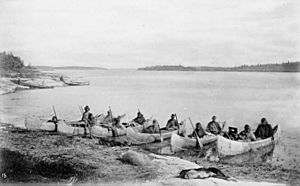
The Nelson River was named by Sir Thomas Button. He was a Welsh explorer who spent the winter at the river's mouth in 1612. He named it after Robert Nelson, a ship's captain who sadly died there.
At that time, the Cree people, who lived along the river, called it Powinigow or Powinini-gow. This name might have meant "the Rapid Strangers' river." The area around the Nelson River was important for the fur trade. However, the Hayes River, which is very close to the Nelson's mouth, became the main route for traders going inland.
Fort Nelson was a historic trading post belonging to the Hudson's Bay Company. It was located at the mouth of the Nelson River on Hudson Bay and was a very important trading spot in the early 1700s. Pierre Esprit Radisson, a famous French explorer who helped start the Hudson's Bay Company, was even in charge of trade at Fort Nelson for a time. Today, Fort Nelson no longer exists. Port Nelson, the abandoned shipping port, is still there on the opposite side of the river's mouth.
The Nelson River is very powerful because it carries a huge amount of water and has many drops in elevation. This makes it perfect for generating hydroelectricity (electricity made from moving water). Building dams on the river to create this power has caused some challenges for First Nations communities in the past due to flooding. To help with these issues, the Northern Flood Agreement was created in the 1970s.
The impacts of these developments have been described by people like Peter Kulchyski in 2012:
"Travelling up the Nelson River, it’s easy to see the impacts of hydro development. The once-pristine water is now silty and not to be trusted for drinking. Trees fall into the river everywhere along the shore, thanks to erosion caused by constantly fluctuating water levels. Ancient graves are being exposed, and sacred sites are now under water. What was once a highway for hunters is now dangerous to travel in winter, as the location of ice pockets created by flooding and retreating water cannot be predicted. A river that was once the basis for life has become deadly." Peter Kulchyski 2012
See also
 In Spanish: Río Nelson para niños
In Spanish: Río Nelson para niños


